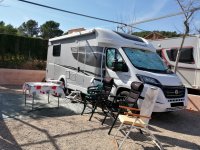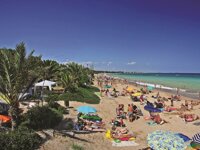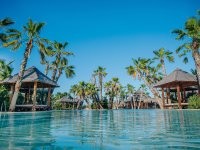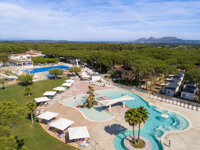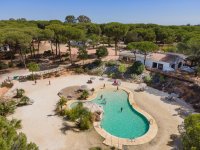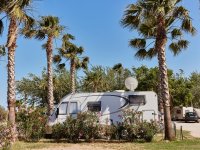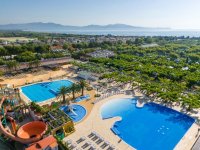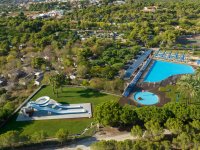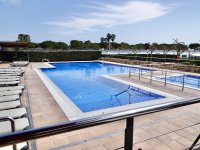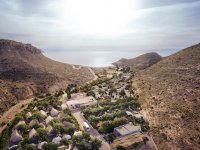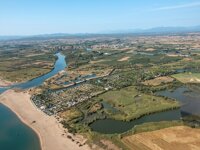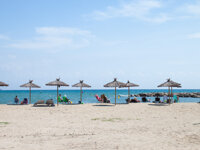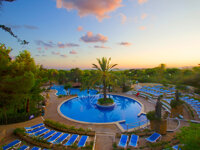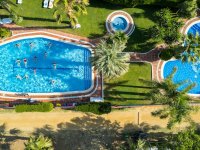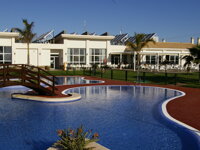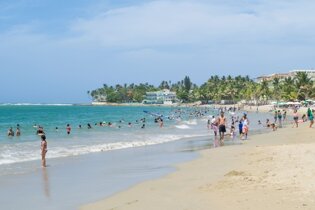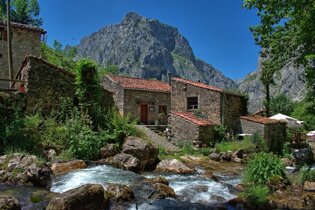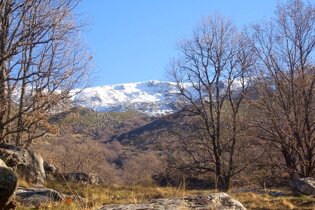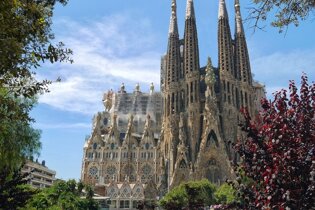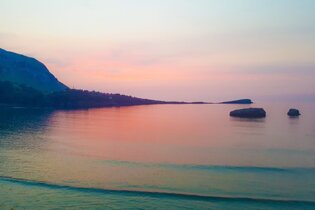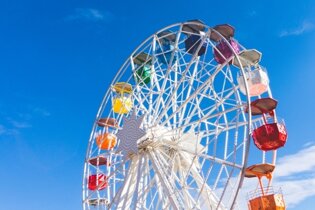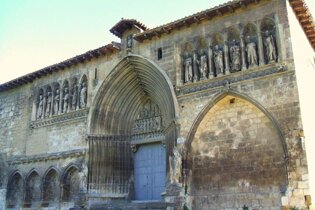Camping in Spain
447 campsites in Spain
Campsite Listing Google Map
The following consent is required:
Tracking & performance, Targeting & advertising.
Spain
One of the largest countries in Europe, with glorious beaches, a fantastic sunshine record, vibrant towns and laid back sleepy villages, plus a diversity of landscape, culture and artistic traditions, Spain has all the ingredients for a great holiday.

Spain has a huge choice of beach resorts to choose from. With charming villages and attractive towns, the Costa Brava boasts spectacular scenery with towering cliffs and sheltered coves. There are plenty of lively resorts, including Lloret, Tossa and Calella, plus several quieter ones.
Further along the east coast, the Costa del Azahar stretches from Vinaros to Almanzora, with the great port of Valencia in the middle. Orange groves abound. The central section of the coastline, the Costa Blanca, has 170 miles or so of silvery-white beaches. Benidorm is the most popular resort. The Costa del Sol lies in the south, home to more beaches and brilliant sunshine, whilst in the north, the Costa Verde is largely unspoiled, with clean water, sandy beaches and
rocky coves against a backdrop of mountains.
Beaches and sunshine aside, Spain also has plenty of great cities and towns to explore, including Barcelona, Valencia, Seville, Madrid, Toledo and Bilbao, all offering an array of sights, galleries and museums.
The laid-back pace is ideal for unwinding, and the country’s many festivals offer a chance to experience Spanish life at its best. From the famous Benicassim music festival in July to the feast of La Virgen de la Vega in Salamanca during September, visitors are spoiled for choice when camping in Spain.
Spain has a range of landscapes, from the soaring peaks of the Pyrenees and Picos de Europa down to the long ribbons of sand on the Mediterranean coast. There is an arid desert, lush valleys and vineyards, fertile fields and scrubby plains. If road-tripping is your thing, check out our guide to Spain’s Mediterranean Coast
Camping in the Spanish interior
The Spanish interior is a vast area, but there are several key regions worth exploring.
Castilla y León
The large region of Castilla y León is located inland, bordering Portugal to the west. It has a rich legacy dating back to the Romans, with an extraordinary wealth of castles, cathedrals and mansions, historic cities and towns. To the south, Avila is surrounded by 11th-century walls and is set on high plains. Salamanca is a graceful city, once home to one of the world’s most illustrious universities. Its grand Plaza Mayor is the finest in Spain. Segovia is known for its magnificent Roman aqueduct, cathedral and the fairytale Alcazár with its turrets and towers. Soria, Burgos (birthplace of El Cid) and Leon are all well worth a visit.
La Rioja
A small region, La Rioja is the most highly regarded wine region in Spain. Rioja is considered one of the finest wines in the world, its production is centred around Haro.
Aragon
Aragon lies to the east and borders Catalonia and the Pyrenees with France to the north. It’s a region rich in folklore with rural mountain villages, Romanesque architecture, lush valleys and jaw-dropping mountain peaks. It’s a great place for walking, admiring nature and spectacular scenery.
Castilla La Mancha
Castilla La Mancha is found south of Madrid in the ancient kingdom of Castille. It encompasses the area known as La Mancha, universally famous as the setting for the great Miguel de Cervantes novel ‘Don Quijote de la Mancha’. There are plains, mountains, Toledo with its monuments and art and the El Greco museum (the brilliant painter was born here). And, yes, you can follow the ‘Don Quijote Route’, which will take you to the famous windmills at Campo de Criptana.
Extremadura
Extremadura is one the most beautiful, and perhaps least known, regions of inland Spain. Its stunning cities, first Roman, then Moorish, then medieval and aristocratic, gave birth to many of the conquistadors – conquerors of the New World. Sparsely populated, it borders Portugal and features fascinating places like Cácares with its Moorish walls, Plasencia’s Gothic cathedral and Trujillo, the birthplace of Pizzaro, the conqueror of Peru.
Camping and Caravanning on the Costas
It’s the beaches that are the biggest draw – for many, Spain is all about the lure of the costas. When camping or motorcaravanning in Spain you’ll find a huge choice of beach campsites.
With charming villages and attractive towns, people go camping and caravanning on the Costa Brava for the spectacular scenery, high cliffs and sheltered coves. Beginning some 40 km north of Barcelona, the Costa Brava includes the entire shoreline of Girona, an area of great natural beauty with small coves and steep cliffs. The lively resorts include Lloret de Mar, Tossa de Mar, Roses, L’Escala, Sant Pere Pescador, Palamós, Palafrugell and Calella and a number of quieter spots.
Further along the coast, the Costa del Azahar stretches from Vinaros to Almanzora, with the great port of Valencia in the middle, the surrounding hills cloaked in orange groves.
Camping on the Costa Blanca is popular for its 170 miles of silvery-white beach. Benidorm is the most well-known resort. To the south lies the Costa del Sol, a magnet for campers, caravanners and motorhomers, blessed as it is with countless beaches and countless hours of sunshine.
In the far north, on the Atlantic coast, camping on the Costa Verde is a different proposition: largely untouched, with clean water, sandy beaches and rocky coves, it’s sheltered by the immense backdrop of the snow-capped mountains.
The Mediterranean coast of Spain
Catalonia
Camping and caravanning in Catalonia is made easy by a large number of high-quality campsites. You’ll find some very large Catalonian campsites suitable for tents, caravans and motorhomes, most offering serious facilities like aqua parks, restaurants, spa facilities and loads of kids activities. The region of Catalunya, with its independent identity, is full of rich contrasts embracing modernity and ancient tradition in equal measure. It has its own style of cuisine, which displays Iberian, Italian and Arab influences, and encompasses everything from variations on paella to the unique crema catalana, a must-try dessert.
Barcelona
Barcelona is the historical capital of Catalunya and Spain’s second city after Madrid. The beautiful city has an impressive architectural heritage that includes the Gothic Quarter, with its cathedral, the old City Hall, the Episcopal Palace and the Palace of the Generalitat. The city also boasts works by the incomparable modernist architect Antonio Gaudi.
Valencia region and Murcia
This Mediterranean region is famous for magnificent orange groves and long sandy beaches. Centuries of Moorish influence have resulted in a profound Hispano-Moorish heritage. The glorious Orange Blossom coast wraps around Valencia city, with great beaches around Benicassim and Peñiscola. The nightlife is vibrant, and the festivals are numerous
Murcia offers sandy beaches with dunes and unspoilt coves along the coast. Inland are hills and valleys and regional parks like Sierra de Carche, Sierra de la Pila, Sierra de Espuña Carrascoy and El Valle. These are magnificent, with a huge variety of flora and fauna. The capital, Murcia, was founded by the Moors in the 9th century and has a range of museums, the square of Cardinal Belluga, the Episcopal Palace and the cathedral.
Andalucia
Famous for its sun, its beautiful traditions, its poets, original folklore, age-old history and magnificent heritage left behind by the Moors, Andalucia is one of the most attractive regions in Spain. No surprise that is popular with caravanners and motorcaravanners in winter. Many head to Andalucian campsites for the balmy winter sun and excellent value.
With the river Guadalquivir running through it, the charming city of Seville is one of the most visited places. The old city, with its great monuments: the Giralda Tower, cathedral and the Alcázar, plus the narrow, winding streets of Santa Cruz, is particularly popular.
Cordoba is northeast of Seville with a picturesque Jewish Quarter along with a rich Moorish heritage. Indeed the Mezquita is one of the grandest mosques ever built by the Moors in Spain.
Further east on the foothills of the Sierra Nevada mountains, Granada is home to the dramatic Alhambra, a group of distinct buildings including the Royal Palace, splendid gardens, and the fortress of Alcazaba. The Sierra Nevada, Spain’s highest range, offers good skiing and trekking. Further south lie the beaches of Costa Tropical and the Costa del Sol, including the resorts of Malaga and Cadiz.
For a good old-fashioned bucket and spade holiday, Andalucia is the obvious choice. With 800km of coastline running into the clear waters of the Mediterranean Sea, it’s the perfect option for sunshine and surf.
Spain at a glance
Climate
Spain has a very varied climate. The north is temperate with most of the rainfall; dry and very hot in the centre; sub-tropical along the Mediterranean.
Language
Castilian Spanish is spoken by most people, with Catalan (northeast), Basque (north) and Galician (northwest) used in their respective areas.
Money in Spain
Currency
- The Euro (€).
Bank Opening Hours
- Mon-Fri 09.00-14.00. Sat 09.00-13.00.
Shop Opening Hours
- Mon-Sat 09.00-13.00/14.00 and 15.00/16.00-19.30/20.00. Many close later.
Public Holidays
- New Year: 1st January
- Epiphany: 6th January
- Saints Day: 19th March
- Maundy Thursday, Good Friday and Easter Monday
- Labour Day: 1st May
- Saints Day: 25th July
- Assumption: 15th August
- National Day: 12 October
- All Saints Day: 1st November
- Constitution Day: 6th December
- Immaculate Conception: 8th December
- Christmas Day: 25th December
Please note Some dates are moveable, so please check before travelling.
